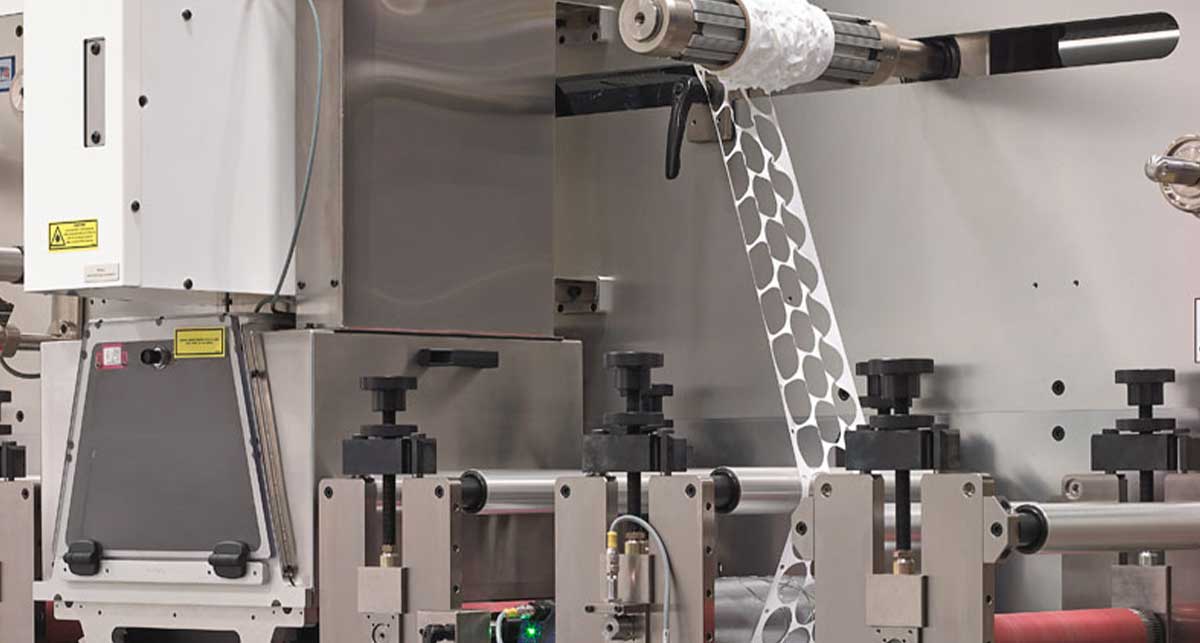It’s been a minute of staring through the screen of a video call, but you’re still stumped. Why does the flexible material converter need to laminate your material?
Industrial lamination isn’t the same lamination you’d see in an office. Manufacturers use adhesives to bond liners and materials to create custom stack-ups with beneficial properties for your particular application.
Strouse builds laminated parts daily, so we understand the challenges of designing and producing precision-laminated parts. Laminating is a critical skill for flexible material converting, and its success relies upon a converter’s ability to innovate the process.
Before getting involved in any large-scale converting project, you should understand what it means to laminate adhesive and the potential problems that could arise in production.
What Does it Mean to "Laminate" Adhesives?
Laminating adhesive is the process of pressing two or more materials together to create a new material. This allows converters to create a material that addresses specific application requirements when materials off the shelf don’t address your needs.
WHEN IS ADHESIVE LAMINATION USED?
Although your mind might jump to paper, many different materials can be laminated together regardless of composition. Every liner, adhesive, and film has its own unique properties and characteristics.
Lamination pairs new configurations of adhesives with liners to create the exact release and stability needed for a product. Through adhesive bonding and lamination, liners are stripped away from existing adhesive rolls, enabling converters to mix and match liners and materials to create a roll that best fits the application.
a. CUSTOM MATERIAL CONFIGURATIONS
Using a single type of adhesive will not be practical for every situation. You might need a differential double-coated tape (a double-sided tape with different adhesives on either side). Unfortunately, there may not already be a product on the market with the right combination of adhesive or liners to attach your desired surfaces.
E.g., Painted metal has a lower surface energy than unpainted metal. When bonding the two, you might ask a converter to laminate a double-sided tape that functions well on both surfaces, creating the ideal bonding solution.
b. AUTOMATED PRODUCTION
Modern manufacturers often employ automated production methods; however, their machines struggle to remove tight-release liners. As a result, they reach out to converters with existing rolls of product and ask us to unwind the material to switch to an easy-release liner.
How Does Adhesive Lamination Work?
Lamination involves bonding two flexible materials together by applying pressure or heat.
Manufacturing facilities use rollers to apply pressure when laminating materials, but because most adhesive materials come in rolls, the laminating process becomes a continuous cycle. Rather than having to stop and switch out parts, converters run the rolls of material through the press to create a steady stream of laminated parts.
WHAT IS WEB LAMINATION?
Web lamination is a subcategory of adhesive lamination. At Strouse, we use it to combine rolled materials on a rotary die cut machine. It includes:
- Multi-layer lamination
- Extended liner laminating
- Liner substitutions
- Zoned adhesive lamination
and is frequently implemented by flexible material converters laminating foams, films, liners, or other substrates using pressure sensitive adhesives.
Using rotary tools, flexible material converters thread two lines of material through the press and regurgitate them as a single line of adhesive material. Incorporating lamination into the die cutting process encourages them to aim for a one-pass press run, where ideally, the material goes in on one side and comes out the other end as fully finished parts.
COMMON PROBLEMS WITH LAMINATING ADHESIVE
Due to the numerous problems that may arise, laminating complex designs can quickly become a challenge that hinges on engineering expertise.
Running a laminating adhesive requires a thorough understanding of how to maintain the correct tension and angles to ensure optimal performance. A converter can achieve total machine press alignment with the correct angles, resulting in a seamless, one-pass process.
a. POOR MATERIAL ALIGNMENT
Using the wrong tension and angles will cause malalignment, resulting in faulty parts with air bubbles that pop or tear and other deformities. For this reason, converters test their machines before fully running a product and make calculated adjustments for better accuracy.
b. CHOOSING INCOMPATIBLE MATERIALS
Another thing to note is that certain materials shouldn’t be joined together. Although laminating silicone adhesive with a silicone release liner is tempting, any converter would redirect you to a fluorosilicone liner instead to prevent the silicone from gluing itself together.
c. USING FLIMSY MATERIAL
Using an exceptionally flexible or flimsy material could lead to problems or excessive material waste later in production due to miscuts.Consider speaking with a converter before purchasing laminating adhesives. Based on your part’s application, the converters can help source a material that enhances your design manufacturability.
When Should I Use Adhesive Lamination?
When you can’t find an adhesive that matches the properties of your substrates, or the “parent” (original) liner doesn’t suit your application method, then it’s time to consider adhesive lamination. Even if you choose difficult-to-laminate material that’s flexible or flimsy, it can probably still be laminated, even if it costs more due to a longer, more complicated labor process.
Although adhesive lamination is used during die cutting processes, converters can also perform adhesive lamination as a standalone process by laminating material or changing liners without a die cut tool on the rotary press.
Whether you want laminated material or parts, a converter has the resources and technical know-how to meet your adhesive needs.
If you're unsure how lamination will affect the cost of your die cut, ask your converter about pricing and how they plan to laminate adhesive to your final design.
Originally published: May 11, 2023







